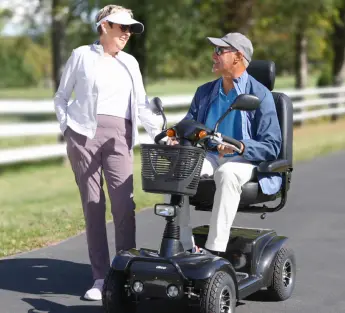How to Buy a Mobility Scooter
Scooters are a popular way for people with some mobility problems to get around in their homes.
|
Mobility scooters are a popular way for people with some mobility problems to get around in their homes, the grocery store, the shopping mall and other important areas in their neighborhood. If you are fatigued after walking to another part of your house or to your mailbox, you can still maintain your independence with the use of a fun and comfortable scooter. Another name for a scooter is PMV or personal mobility vehicle. People who benefit from having a scooter for mobility include people with multiple sclerosis, mild cerebral palsy, severe forms of arthritis. The elderly and stroke survivors also find that scooters help get from here to there without using a product that looks like medical equipment! With more than 40 scooter models to choose from, how do you choose the right scooter for your needs? It’s kind of like shopping for a car. You know what you need to use the car for, so that helps you to choose which car to buy. The same is true for a scooter. Here is an easy checklist to help you decide which is the right scooter for you! Your weight. How much you weigh is the first consideration. When making a purchase, you’ll be asked whether you weight 250 pounds or less, or if you weight more than 250 pounds. The second choice is a more durable scooter to be able to carry that difference in weight. Consider whether you are close to that weight limit, and if you will be carrying heavy objects on your scooter or in your scooter basket! It all adds up! Scooter dimensions. The size of the scooter is going to be important based on your environment. If you use your scooter indoors where the hallways are narrow and the corners are tight, then a smaller scooter with a small turning radius will be your better choice. You can find those measurements in the specifications section when review the details of any scooter. Scooter durability. Eighty percent of scooter buyers purchase a 3 wheel scooter. Scooters come in three general sizes: compact, midsize and rugged outdoor. If you will use your scooter on rough terrain, hilly grass or a rural area like a farm, you probably will want a 4 wheel outdoor scooter. Four wheels adds more stability over rough terrain. A 3 wheel scooter allows better maneuverability in tight spaces. Transportation. Will you be transporting your scooter in the trunk of a car? If so, you need to consider a scooter that disassembles. You also need to consider the size of those individual pieces and the weight of the largest piece. Many scooters do disassemble into three pieces, not including the batteries. The heaviest piece can be as much as 30 pounds. So, you might need to consider how much weight your spouse, friends or caregivers can lift in order to get that into the trunk of your car. Also check the sizes of the pieces to be sure you or a friend can get them into the trunk of the car being used! Alternatively, you could look at scooter lifts. The seat. If you are in and out of your scooter seat all day, then you would probably be fine with the seat that comes standard with your scooter. If you remain in the seat most of the day, you’ll want to consider upgrading to a more comfortable seat that has extra foam padding. Also consider leg room; if you are tall, you will want a seat that can be moved higher. Some seats also swivel for easy access, then lock in place when you are facing forward. More expensive, and thus more comfortable seats, are oftentimes called Captain chairs because they look like the chair/seat used by a captain on a boat. The arms. If you are in and out of your seat, you’ll probably want arms that rotate back out of the way for easy transfer. Some scooters come with arms that can be adjusted wider to allow more room for you and a heavy coat on chilly days, or to help adjust the chair to the most comfortable position for your needs. Accessories. There are many options from pouches to baskets to headlines, and many of these options have an additional charge to them, just like when you bought your car. Take your time when scrolling through the Accessories list when comparing scooters and their value to your needs.
Colors. One of the most popular colors is red, followed by green, then blue. What was the favorite color of your favorite car?! Tires. Most scooters now come with foam-filled tires. These eliminate the problem of flat tires. The Tiller. If you have limited ability to grip, be sure you don’t get a scooter that has knobs for release mechanisms. The tiller is like the handlebars of a bicycle, and it can be moved forward for easy access to sit down, the moved back in place for when you are ready to drive on. Some scooters are made with a lever that allows you to just move it with the push of your hand to release the Tiller. Here is another important checklist of you are not sure if you are ready to buy a scooter. If you agree with the following questions, a scooter may be right for you:
|





 Contact Us
Contact Us
 M-F 9am - 5pm ET
M-F 9am - 5pm ET
 Request parts
Request parts Request Service
Request Service